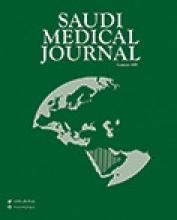Abstract
OBJECTIVE: Several infectious diseases are transmissible by blood transfusion, especially viral infections. The most common blood-transmitted viruses are hepatitis B virus (HBV), hepatitis C virus (HCV) and human immunodeficiency virus (HIV). These viruses cause fatal, chronic and life-threatening disorders. The prevalence of these viruses varies by nationality and geography. The purpose of this study was to establish the current prevalence of hepatitis viruses (B and C) and human retroviruses (HIV-1, 2 and human T-lymphotropic virus type I and II, HTLV-I /II) among blood donors at King Khalid University Hospital (KKUH), Riyadh, Kingdom of Saudi Arabia (KSA).
METHODS: Serological markers of HBV, HCV, HIV 1, 2 and HTLV-I/II were studied in 24173 (23952 males and 221 females), 20423 Saudi and 3750 non-Saudi blood donors, using commercially available kits, over a period of 3 years from January 2000 to December 2002 at KKUH, Riyadh, KSA. The prevalence of confirmed-positive test results of these viruses was evaluated among different gender, ages and nationalities.
RESULTS: During the study period, prevalence rates of HBV and HCV infections were 1.5% and 0.4%, and zero for retroviral infections. The prevalence was not significantly higher in male than in female donors. Hepatitis B surface antigen (HBsAg) and anti-HCV positivity tend to increase with increase in age. The prevalence of HBsAg and anti-HCV positivity was significantly more prevalent among non-Saudi compared to Saudi donors.
CONCLUSION: This study highlights the prevalence rates of HBV and HCV among different groups. The prevalence varies from one group to another, being the lowest among Saudi and young donors. Therefore, extensive recruitment of Saudi and young donors should help ensure a long-term increase in the blood supply without jeopardizing safety.
- Copyright: © Saudi Medical Journal
This is an open-access article distributed under the terms of the Creative Commons Attribution-Noncommercial-Share Alike 3.0 Unported, which permits unrestricted use, distribution, and reproduction in any medium, provided the original work is properly cited.






